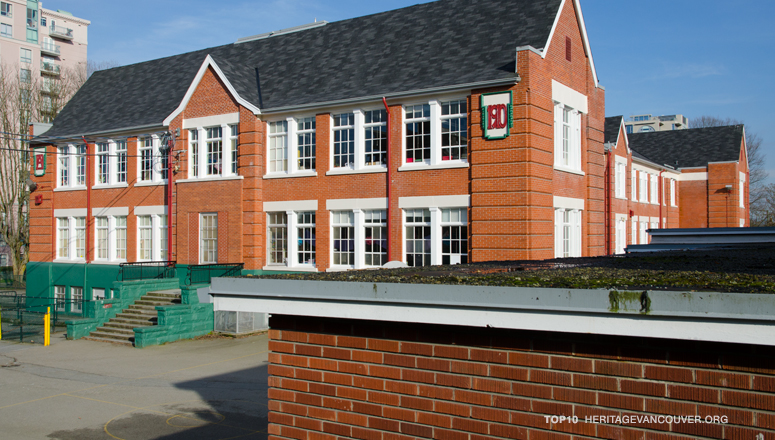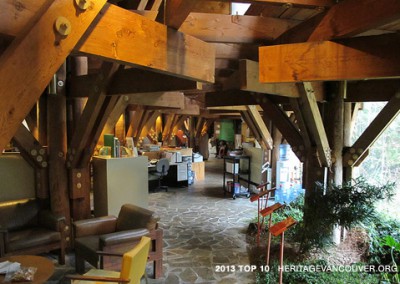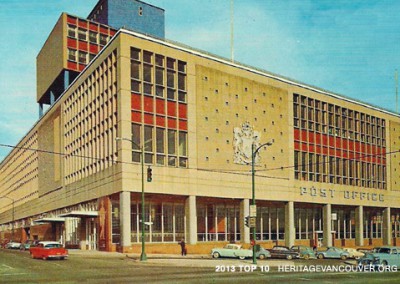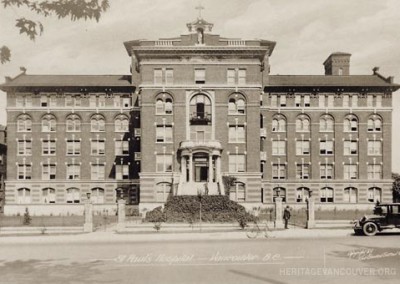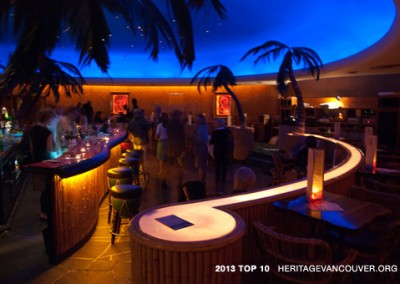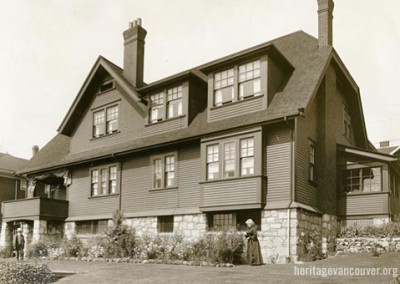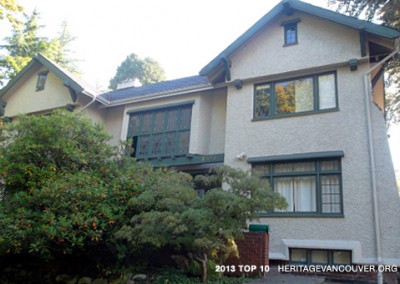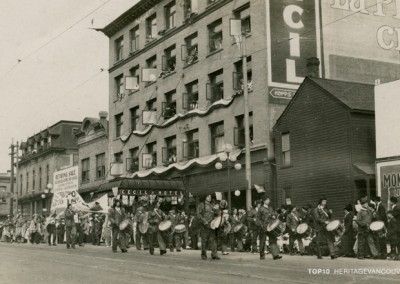The Cecil Rhodes Public School building, known since 1977 as “L’Ecole Bilingue”, has recently been condemned to “seismic replacement”.
The building is located in Fairview, on 14th Avenue at Alder Street, and was designed by the Vancouver School Board architect Norman Leech in 1911-1912.
Constructed with two classroom wings flanking a central core, it is a two-storey plus basement masonry building with prominent quoined corner pilasters. The school has generous fenestration, and its original wooden windows are in excellent condition. The main entrance is surmounted by an intricate glazed transom and its landing embodies its former name in mosaic. Chestnut trees and landscaping around L’Ecole Bilingue distinguish its property while contributing a tranquil urbanity to its immediate environment.
Over the years, a number of its original features have been removed. Despite this loss of some architectural value, this neighbourhood landmark remains a reflection of its original panache and encapsulates several important pages of Vancouver’s history. L’Ecole Bilingue is listed in the “B” category on the Vancouver Heritage Register.
L’Ecole Bilingue is just one of a number of historic schools that we could lose in the next round of the Vancouver School Board’s seismic mitigation initiative.
Threat
What is the threat to L’Ecole Bilingue (Cecil Rhodes)?
The Ministry of Education has recognized the need to address the seismic upgrading of public schools since the late 1980s, when it initiated seismic assessments of schools and funded several structural upgrading projects in Vancouver and Victoria in 1991 and 1992. The program was then suspended and later reinstated by the Ministry of Finance in 2000 and transferred again to the Ministry of Education in 2004. Based on new structural seismic risk assessment, the ministry formally launched the Seismic Mitigation Program in March of 2005.
The Ministry of Education indicates that, as of August 2012, 143 seismic upgrade projects across British Columbia had been completed or are under construction.
Vancouver has been very slow at making its schools safer; according to these statistics only 21 Vancouver schools out of its 108 schools have been upgraded, less than 15% of the total provincial program. These include demolished schools such as Charles Dickens Elementary and General Gordon, replaced schools such as Lord Kitchener and Kitsilano High or abandoned schools like Sexsmith and James Douglas.
The delay in Vancouver was caused by the extensive planning and the preparation of the School Board’s Capital Plan, which was issued last September. The Board’s strategy is to take advantage of the Seismic Mitigation Program to modernize its schools. Whether or not to upgrade an existing school depends largely on the extent of “deferred maintenance” which has been common practice for years in Vancouver.
“Seismic Mitigation” is just one part of the equation, even if it should have been a priority; “Seismic Mitigation” alone is the cheapest upgrade option and could have been undertaken at any time since the beginning of the program. Pressure from teachers, parents and students has precipitated an avalanche of “Seismic Mitigation” projects to come forth, and rightfully so. Out of the 26 schools currently approved by the Ministry to proceed to the planning stage, ten are located in Vancouver.
The planning process for a renewed school is extensive. Options are typically developed by consultants, and then presented at open houses for public assessment. In the case of l’Ecole Bilingue four options were developed for review:
Option 1: Upgrade & Addition;
Option 2A: Partial Replacement (West site);
Option 2B: Full Replacement (West site, at existing school location);
Option 3: Full Replacement (East site at playing field location).
Of the 92 people attending the Open House, 56 returned comment forms of which 33 respondents favoured either of the replacement options, while 21 favoured the upgrade/addition option, and 2 favoured none of the options.
An Option 4: was developed at the City’s request for a fuller exploration of a partial retention concept; it was not ready for the Open House and subsequently was rejected by the Advisory Committee and never displayed to the public.
The VSB adopted Option 2A, a full replacement on the West site. In addition, the project was not brought to the Vancouver Heritage Commission for review, which is normally standard procedure in the case of Heritage Register-listed structures.
On January 29, 2013, the BC Government announced a $15.2 Million project agreement between the Ministry of Education and the Vancouver School Board, which “paves the way for the seismic replacement of L’Ecole Bilingue elementary”. In spite of an all-time high demand for French Immersion Education, the press release goes on to say that “L’Ecole Bilingue is one of three French Immersion-only schools in the Vancouver district and serves a large catchment area. As part of the project agreement, $3.2 Million is being invested to create temporary accommodations in the South Hill Education Centre property for students while construction on the new school is underway.”
“At a recent information session at Vancouver’s L’Ecole Bilingue, parents were told there will likely be more than 100 children put into a lottery for just three dozen available spots.”
Significance
Why is l’Ecole Bilingue (Cecil Rhodes) significant?
This neighbourhood school has served its community for more than one hundred years and stands proud in the city, setting an example for its urbanity. It is important for its history, its architecture and its community landmark status.

Photo: L’Ecole Bilingue, formerly Cecil Rhodes School of Commerce, built in 1911-12, 1166 West 14th Avenue. Photo by Leonard Frank (VPL 4625)
The school is associated with several trends in education: some classes were used for practice by the Normal School students; some high school classes took place in the building in 1917; it became the first commercial school in the City in 1918; and it became one of the first BC French language schools in 1977.
Its original Beaux-Arts architecture was designed by Norman Austin Leech (1880-1945). He was Chief Architect for the Board of Education and designed nearly 20 school buildings for the Board from 1910 to 1914. In addition to Cecil Rhodes, his projects included General Gordon, Lord Nelson and Lord Tennyson public schools, Britannia High School and Sir James Douglas School. Leech was born in Winburg, South Africa and was educated at King’s College, University of London where he received the Gold Medal for architecture in his final year. He lectured at the Technical Institute at Norwich, England, then returned to South Africa and practised in Johannesburg in 1902-06. Leech immigrated to Canada in 1906 and settled in Vancouver where he focused on the design of local schools.
The building was estimated 10 points out of 10 for its architectural value in the 2007 Commonwealth Report commissioned by the Vancouver School Board. The report states that the original building is an example of a school with restrained classical features and a ‘barbell’ plan. Most of Leech’s schools were executed in the Edwardian style, and constructed of brick cladding in a formally composed symmetrical plan that allowed for easy expansion.
Its construction is associated with the tremendous expansion of Vancouver before World War I. Like many schools built at the time, it was constructed in two consecutive stages that reflected Vancouver’s rapidly-growing population. At the time, Fairview was a family neighbourhood and Cecil Rhodes Elementary was the school that provided many of the local kids a stepping stone to remarkable lives here and abroad; graduates from the school included Chief Justice of the Supreme Court of British Columbia, UBC Chancellor Nathan Nemetz, Vancouver Symphony and Osaka Philharmonic Concert Master Gerald Jarvis and beloved Vancouver Sun columnist Denny Boyd amongst others.
L’Ecole Bilingue opened in September 1973 in David Lloyd George Annex. L’Ecole was designated a separate school in 1976, and moved to Cecil Rhodes in 1977. L’Ecole Bilingue contributed greatly to the promotion of the French language in BC, which helped fuel, the popular enthusiasm for a French education in Vancouver. L’Ecole Bilingue is also valued because of its role in the community. The participation in the “Greening of BC School Grounds” in 1995 by students, staff and parents of l’Ecole Bilingue is evidence of the school’s contribution to the improvement of the city environment. The landscape around l’Ecole Bilingue is a reminder of the collective effort and testifies to the vitality of the school.
Position
Heritage Vancouver’s position
Heritage Vancouver believes that l’Ecole Bilingue should be maintained and upgraded. The building has a concrete frame structure and several of its amenities are in good condition. Several parts of its original architecture can be rehabilitated or restored. The building base, for instance, can be stripped of its coating and the original stone revealed. L’Ecole Bilingue is a perfect candidate for a first-class conservation project and the building could continue to serve its community far into the future.
Heritage Vancouver believes that many years of “deferred maintenance” is not an excuse to obliterate community assets. The Ministry of Education and the Vancouver School Board, past and present, have beguiled the public confidence in letting Vancouver’s heritage buildings deteriorate to a point that, they say, is of no return. “Seismic replacement” should not be an option when mitigation could have been implemented at any time since 2005 and upgrading should have been achieved by incremental interventions.
Heritage Vancouver believes that a thorough “Conservation Plan” of l’Ecole Bilingue must be prepared by a qualified heritage professional before any final plans are executed. This Conservation Plan should include a Statement of Significance and document character defining elements subject to intervention. The conservation plan should prescribe the preservation, rehabilitation, restoration and ultimately, the recovery and reuse of l’Ecole Bilingue’s character defining elements.
Our historic neighbourhood schools are community assets and should not be allowed to vanish without documentation and a recovery plan. Heritage Vancouver believes that a recognized third party be involved in assessing the value of heritage structures in any upcoming school projects. We believe that a heritage organization operating at arm’s length can ensure that the community asset, our heritage schools are treated according to established conservation principles. In addition, a third party will be a better judge of the importance of retaining these heritage structures.
